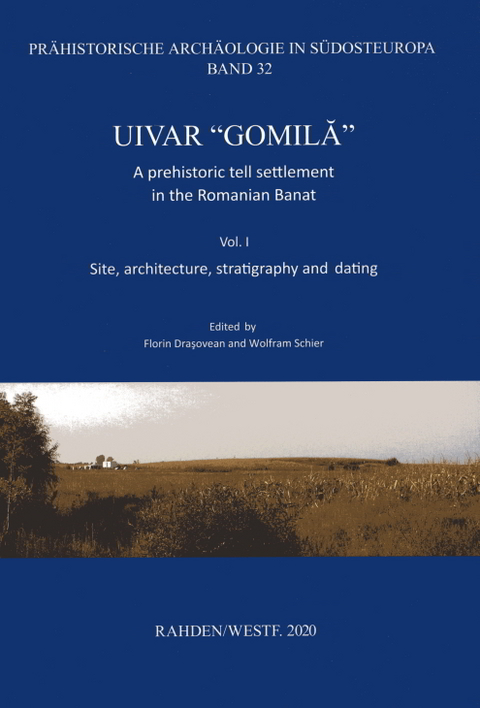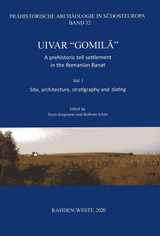Uivar "Gomilă"
A Prehistoric Settlement in the Romanian Banat. Vol. I: Site, Architecture, Stratigraphy and Dating
Seiten
2020
|
1., Aufl.
VML Vlg Marie Leidorf (Verlag)
978-3-89646-687-7 (ISBN)
VML Vlg Marie Leidorf (Verlag)
978-3-89646-687-7 (ISBN)
Despite its prominence in the landscape, the South-Western Romanian tell site at Uivar, distr. Timiş, was only discovered in the 1990s. It is situated in the Banat Lowlands at the River Timişaţ some 40 km from Timişoara, close to the Serbian border. Excavations were carried out between 1999 and 2009 and revealed a Middle to Late Neolithic occupation of the Vinča and Banat Cultures with rectangular post buildings with wattle-and-daub walls partly decorated by colour and applications [ca. 5250-4550 B.C.]. Of the four Neolithic settlement phases [5-2], phase 4b featured the most important architectural remains with a large building of five rooms in the ground floor and three in an upper storey and a potential altar. The tell had a defensive system with an internal ditch of 1.8 km and an external ditch of 4.2 km in length. The present first volume on topics such as stratigraphy, excavation, geophysics, features, dating, and fortifications will be followed by another two on small finds, bioarchaeology and palaeoenvironment, typo-chronology, and house architecture. More recent remains at Uivar belong to the Bronze and Iron Ages and to Medieval and Early Modern times. Die südwestrumänische Tellsiedlung von Uivar, Kr. Timiş, wurde trotz ihrer Prominenz in der Landschaft erst in den 1990er-Jahren als solche erkannt. Sie liegt am Fluß Timişaţ, ca. 40 km von Timişoara, unweit der Grenze zu Serbien, in der Banater Tiefebene. Von 1999-2009 wurden Ausgrabungen durchgeführt, die ergaben daß eine mittel- und endneolithische Besiedlung der Vinča und Banat Kulturen mit rechteckigen Pfostenbauten mit z. T. bemaltem und plastisch verziertem Lehmflechtwerk bestand [ca. 5250-4550 v.Chr.]. Von vier neolithischen Siedlungsphasen [5-2] enthielt die Phase 4b die bedeutendste Architektur mit einem Großbau aus fünf Räumen im Erd- und drei im Obergeschoss sowie einem möglichen Altar. Der Tell besaß ein Befestigungssystem mit einem inneren Grabensystem von 1,8 km und einem äußeren von 4,2 km Länge. Auf diesen ersten Band mit Themen wie Stratigraphie, Ausgrabung, Geophysik, Befunden, Datierung und Befestigung folgen zwei weitere Bände zu Kleinfunden, Bioarchäologie und Paläoumwelt, Typochronologie und Hausarchitektur. Jüngere Hinterlassenschaften Uivars stammen aus Bronzezeit, Eisenzeit und Neuzeit sowie dem Mittelalter.
Despite its prominence in the landscape, the South-Western Romanian tell site at Uivar, distr. Timiş, was only discovered in the 1990s. It is situated in the Banat Lowlands at the River Timişaţ some 40 km from Timişoara, close to the Serbian border. Excavations were carried out between 1999 and 2009 and revealed a Middle to Late Neolithic occupation of the Vinča and Banat Cultures with rectangular post buildings with wattle-and-daub walls partly decorated by colour and applications [ca. 5250-4550 B.C.]. Of the four Neolithic settlement phases [5-2], phase 4b featured the most important architectural remains with a large building of five rooms in the ground floor and three in an upper storey and a potential altar. The tell had a defensive system with an internal ditch of 1.8 km and an external ditch of 4.2 km in length. The present first volume on topics such as stratigraphy, excavation, geophysics, features, dating, and fortifications will be followed by another two on small finds, bioarchaeology and palaeoenvironment, typo-chronology, and house architecture. More recent remains at Uivar belong to the Bronze and Iron Ages and to Medieval and Early Modern times.
Despite its prominence in the landscape, the South-Western Romanian tell site at Uivar, distr. Timiş, was only discovered in the 1990s. It is situated in the Banat Lowlands at the River Timişaţ some 40 km from Timişoara, close to the Serbian border. Excavations were carried out between 1999 and 2009 and revealed a Middle to Late Neolithic occupation of the Vinča and Banat Cultures with rectangular post buildings with wattle-and-daub walls partly decorated by colour and applications [ca. 5250-4550 B.C.]. Of the four Neolithic settlement phases [5-2], phase 4b featured the most important architectural remains with a large building of five rooms in the ground floor and three in an upper storey and a potential altar. The tell had a defensive system with an internal ditch of 1.8 km and an external ditch of 4.2 km in length. The present first volume on topics such as stratigraphy, excavation, geophysics, features, dating, and fortifications will be followed by another two on small finds, bioarchaeology and palaeoenvironment, typo-chronology, and house architecture. More recent remains at Uivar belong to the Bronze and Iron Ages and to Medieval and Early Modern times.
| Erscheinungsdatum | 05.05.2021 |
|---|---|
| Reihe/Serie | Prähistorische Archäologie in Südosteuropa ; 32 |
| Verlagsort | Rahden |
| Sprache | englisch; deutsch |
| Maße | 210 x 297 mm |
| Gewicht | 2380 g |
| Einbandart | gebunden |
| Themenwelt | Geschichte ► Allgemeine Geschichte ► Vor- und Frühgeschichte |
| Schlagworte | Farbe • Grabenanlage • Hausbau • Maske • Siedlungsarchäologie • Tellsiedlung |
| ISBN-10 | 3-89646-687-9 / 3896466879 |
| ISBN-13 | 978-3-89646-687-7 / 9783896466877 |
| Zustand | Neuware |
| Haben Sie eine Frage zum Produkt? |
Mehr entdecken
aus dem Bereich
aus dem Bereich
auf den Spuren der frühen Zivilisationen
Buch | Hardcover (2023)
C.H.Beck (Verlag)
CHF 27,95
Was Pompeji über uns erzählt
Buch | Hardcover (2023)
Propyläen (Verlag)
CHF 44,75




